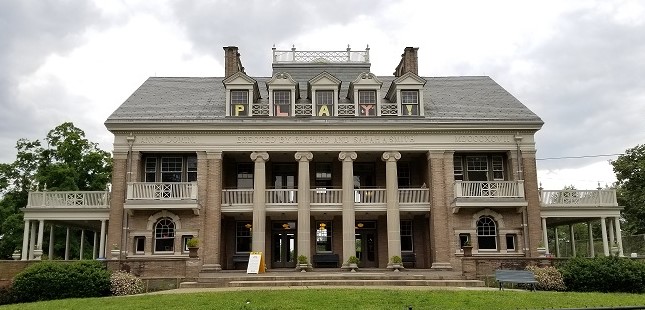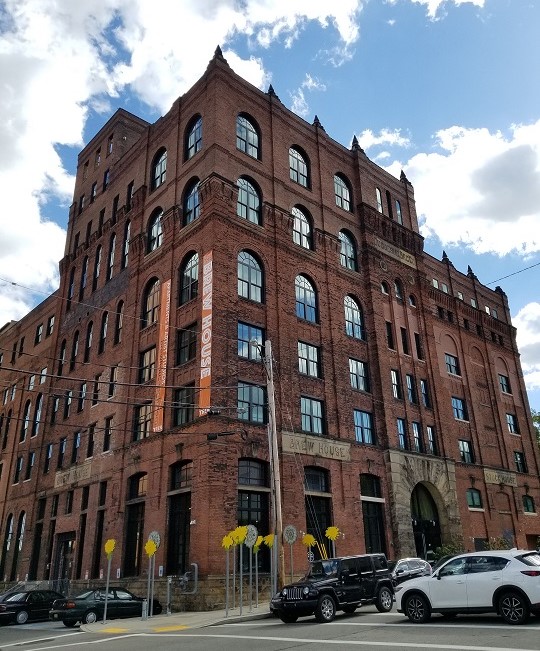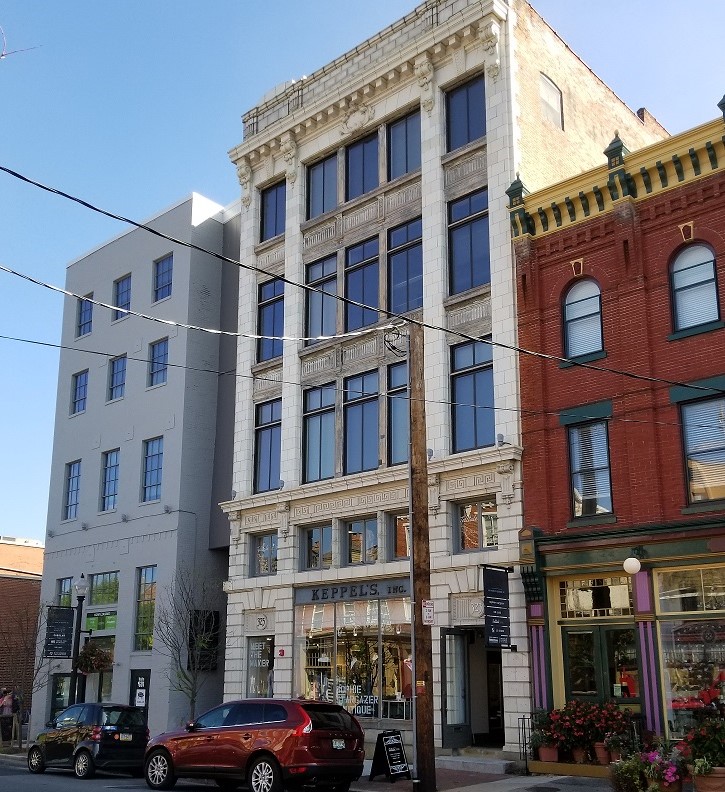The Chinese calendar says 2019 is the Year of the Pig. I’m feeling optimistic and thinking that 2019 might also be the Year of the Pennsylvania Historic Preservation Tax Credit.
What is the Pennsylvania Historic Preservation Tax Credit (PA HPTC)?
The Pennsylvania Historic Preservation Tax Credit (PA HPTC) provides tax credits to qualified taxpayers who are rehabilitating a qualified historic structure into an-income producing property in a manner that is consistent with the Secretary of the Interior’s Standards for Rehabilitation.
Gov. Tom Corbett signed the Pennsylvania Historic Preservation Tax Credit into law as part of the overall statewide budget package in July 2012 but, unfortunately, the law was written for the program to sunset after State Fiscal Year 2019-2020 (which is July 1, 2019 to June 30, 2020).
The program is administered by the Department of Community and Economic Development in partnership with the Pennsylvania Historical and Museum Commission and Department of Revenue.
This program is often used as a complement to, but shouldn’t be confused with, the federal historic preservation tax credit.

The Smith Memorial Playhouse in Fairmount Park was an applicant for the SFY18 PA Historic Preservation Tax Credits.
How it Works
Tax credits may be applied against the tax liability of a qualified taxpayer. A visit to the DCED webpage about these tax credits can give you the nitty gritty details.
The commonwealth issues a maximum of $3,000,000 in tax credits each fiscal year with dozens and dozens of applicants seeking a piece of that pie. Because the number of applications far exceed the limited $3 million available for credits:
- The total tax credits awarded to a qualified taxpayer may not exceed $500,000 in any fiscal year and cannot be more than 25 percent of the qualified expenditures;
- The tax credits must be equitably distributed across 5 regions, which are defined by DCED; and
- Applications are reviewed on a first-come, first-served basis.
Here are some program stats from the first through fifth year: 182 applications were received with over $56.6 million in requested credits and 81 projects were funded with the $15 million in credits available ($3 million per year over 5 years).
For more details about the annual allocations, check out these posts: Year 1 recap, Year 2 recap, Year 3 recap, and Summer 2018 Update.

The Duquesne Brew House in Pittsburgh was rehabilitated into artist housing using both the federal and PA Historic Preservation Tax Credits.
The Process
Applicants have one opportunity a year to apply for the credits. An outline of the process is available on PHMC’s website. Here’s a quick summary:
- DCED announces the opening date for each application round and then manages the application process through their Electronic Single Application (ESA) system.
- PA SHPO tax credit staff review the submitted applications to determine eligibility. PA SHPO first certifies that the property being rehabilitated is a qualified historic structure; for those that qualify, PA SHPO then reviews the proposed work to certify that it meets the Standards.
- After PA SHPO identifies the list of eligible candidates, DCED makes the determination from the pool of eligible projects and allocates tax credit certificates for those selected.
- For projects that receive credits, PA SHPO tax credit staff review any changes to the scope of work that arise during construction and may visit the property to help troubleshoot a problem with the property owner, architect, contractor, or consultant.
- Once the project is completed, we review the final application to make sure the rehabilitation was completed as approved.
- After PA SHPO certifies the completed project, the Department of Revenue processes the tax credit certificates and monitors the taking of the credit on tax returns.

The Keppel Building in Lancaster was rehabilitated for market rate housing and multi-tenant retail using the federal and state historic preservation tax credits.
Why this year?
State Fiscal Year 2019-2020 is fast approaching, and with it the “sunset” provision in the legislation.
Last year, Preservation Pennsylvania started working with the historic tax credit development community and members of Pennsylvania’s General Assembly – specifically Senator David Argyll (R-Schuylkill/Berks) and Representative Robert Freeman (D – Northampton) – to reauthorize the program in Fiscal Year 2018-2019, a year ahead of schedule.
The goal is not only to reauthorize it but to also improve it.
Happenings to Date
There are two key things you need to know about what’s been happening to date:
- Preservation Pennsylvania engaged Donovan Rypkema of PlaceEconomics to complete a study of the economic benefits of state tax credits, comparing Pennsylvania’s program to other states. Early findings show that with strong state historic preservation tax credit programs have increased investment in their communities.
- Senator David Argall (R-Schuylkill/Berks and Chairman, Senate Majority Policy Committee) hosted a workshop in June 2018 to hear from property developers, municipalities, Preservation Pennsylvania, PHMC, DCED, and other state agencies on the value of the credit and ways to improve it. You can see the list of participants, watch a video of the proceedings, and view supporting materials here.
Working with recommendations from developers, historic preservation professionals, and other statewide nonprofits working in the field of economic development, Senator Argall’s staff drafted legislation to reauthorize, expand, and improve the credit.
Senate Bill 1279
Senator David Argall introduced SB 1279 in November 2018 and it was referred to the Senate Finance Committee. Because the bill was introduced at the end of the legislative session, it did not get a hearing and will need to be reintroduced in the 2019-2020 session.
Key changes in the reauthorization are:
- Annual Allocation of $30 million (from a current level of $3 million)
- Increased per project cap to $2.5 million (from a current level of $500,000)
- Additional 5% credit for workforce housing
- Clarification that the credit can be used in one year (compared to 5 years for federal)
- Standardization of timing for application, review and allocation
The most significant change is the increase of the annual allocation from $3 million to $30 million. For comparison, here is what our neighbors do with their state historic preservation tax credits:
- New York does not have a cap on annual allocation and a per project cap of $5 million.
- Ohio has a $60 million annual cap and a per project cap of $5 million.
- West Virginia has a $30 million annual cap and a per project cap of $5 million.
- New Jersey and Delaware don’t have state historic preservation tax credits.
What’s Next?
Pennsylvania’s Independent Fiscal Office (IFO) is finishing up a performance-based budget and efficiency review on the PA HTC program and is presenting their findings to the Performance-Based Budget Board at their meeting on January 24, 2019. It is hoped that the IFO review recommends similar program changes as proposed in SB 1279.
The next steps in the reauthorization process are likely to occur after the Governor announces the proposed budget in February 2019. Senator Argall is expected to reintroduce SB 1279 to reauthorize, expand, and improve the credit in March 2019.
Preservation Pennsylvania is expected to release the PlaceEconomics report on the economic benefits of state tax credits to coincide with Senator Argall’s reintroduction of the legislation.
Get in Touch!
If you are interested in historic tax credit programs, please contact me (Scott Doyle, 717 783-6012 or midoyle@pa.gov) or Shawn Massey (717 783-9920 or shmassey@pa.gov) to discuss your project or schedule a site visit. We are also available to provide workshops on the historic tax credit program for your community or organization!
State historic tax credits are an important tool for redevelopment in Pennsylvania. Now is a great opportunity to improve the PA HPTC program.
Why does it always have to be commercial properties that receive the grants? We knowingly invested (yes, invested) in a 1730’s-1750’s 13, now 14 room home in York. The interior and some of the exterior had been beautifully restored by the previous owners, but in 2018 we invested over $80,000 in a new roof, window restoration, and necessary repointing of some of the stone. We have been here 4 and a half years and have painted the carriage house, added a fenced in animal area, started to replace the original orchard, switched the propane heat to gas, replaced the wood burning fireplace and lined the chimney, added half a bath, and planted 10 guardens. Currently the original water pump needs restored, the steps to the driveway and the stone wall are falling down, the Victorian porch needs removed, the clapboard siding needs painted, all 8 of the corner fireplaces need video taped to determine if they can be used, the hearths require repair, and the windows need historically accurate shutters. THIS is NOT an ordinary farmhouse. It was built in English fashion by Peter Wolf (a German). Peter is Governor Wolf’s Great, Great, Great…..Grandfather who immigrated from Germany when he was just shy of his second birthday. We are fully aware that we will never get a return on the money we invested in this lovely home. We do it because York deserves to have it’s history preserved—-ALL ITS HISTORY, NOT JUST THE COMMERCIAL BUILDINGS. We tell visitors (we do give tours frequently—for free) that we don’t own this home, we are just the temporary caretakers; that THEY are the true owners because the house is the very fabric of their history.